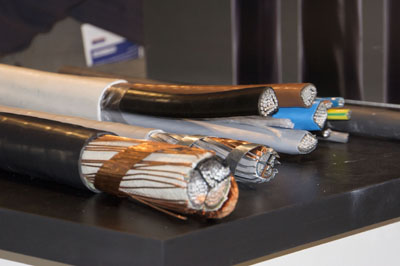
The main properties which make aluminium a valuable material are its low density, strength, recyclability, corrosion resistance, durability, ductility, formability and conductivity. Due to this unique combination of properties, the variety of applications of aluminium continues to increase. It is essential in our daily lives. We cannot fly, go by high speed train, high performance car or fast ferry without it. Nor can we get heat and light into our homes and offices without it. We depend on it to preserve our food, our medicine and to provide electronic components for our computers.
Aluminum also has many advantages for electrical applications. It is lightweight, strong, corrosion resistant, and a highly efficient conductor (aluminum has twice the conductivity, per pound, of copper)—rendering it the material of choice for transmitting power from generating stations to homes and businesses. It is also infinitely recyclable, making it a perfect fit for today's environment.
Although aluminium is, after oxygen and silicon, the third most abundant element in the Earth's crust, it is by far the youngest of the major industrial metals, first produced on a commercially significant scale only just over a hundred years ago. Like lead, tin, iron aluminium exists naturally only in the form of compounds. Sir Humphrey Davy was the first, in 1807, to separate it from its oxide, alumina, though only in the form of an aluminium- iron alloy, and it was he who gave the metal its name.
A Frenchman, Henri St. Claire Deville, developing earlier work by the German scientist Friedrich Wohler, used a complex thermo-chemical method to produce small quantities of metallic aluminium in 1855. The strange new metal enjoyed a modest vogue in jewellery and cutlery, but, although the price dropped considerably over the next thirty years, it remained far too expensive for commercial use.
The breakthrough came in 1886 when, working quite independently, Paul-Toussant Heroult in France and Charles Martin Hall in the USA published patents for the molten electrolytic process of producing metallic aluminium from alumina. Shortly afterwards, Dr Carl Josef Bayer in Austria patented his technique for converting bauxite ore to alumina.

The basis was laid for the methods used in aluminium production all over the world today, and still known as the Bayer Hall-Heroult process.
Almost all electric lights, motors, appliances and power systems depend on a vast grid of aluminium wire. Around the world most high-voltage overhead transmission and distribution lines and many underground lines are made of aluminium. Aluminium replaced copper in high-voltage transmission lines after 1945 and today is the most economical way to transmit electric power.
Aluminium is also widely used in "switchyards" or substations where electricity is stepped down to lower voltages for local distribution. Many substations are almost all aluminium.The power systems of the world's largest buildings are made of aluminium.
Since the 1950s aluminium has practically replaced brass as the standard base for the electric light bulb.
Thousands of television antennae and many satellite dishes are also made of aluminium.
For electrical cables the mechanical properties are very important as illustrated in the dedicated case study on electrical cables.
Additionally, the use of aluminium for electrolytic capacitors is also a large application area. The possibility of rolling aluminium into thin foil and being able to change its capacitance through etching and anodising is a major benefit as illustrated in the section on electrolytic capacitors under dielectric surface properties.
Due to its high thermal conductivity, aluminium is also very well suited for heat exchanger tubes, connections and brazing sheet. Aluminium brazing sheet is an innovation allowing the complicated design of the heat exchanger to be assembled in one production step, as illustrated in the dedicated case study on heat exchangers.